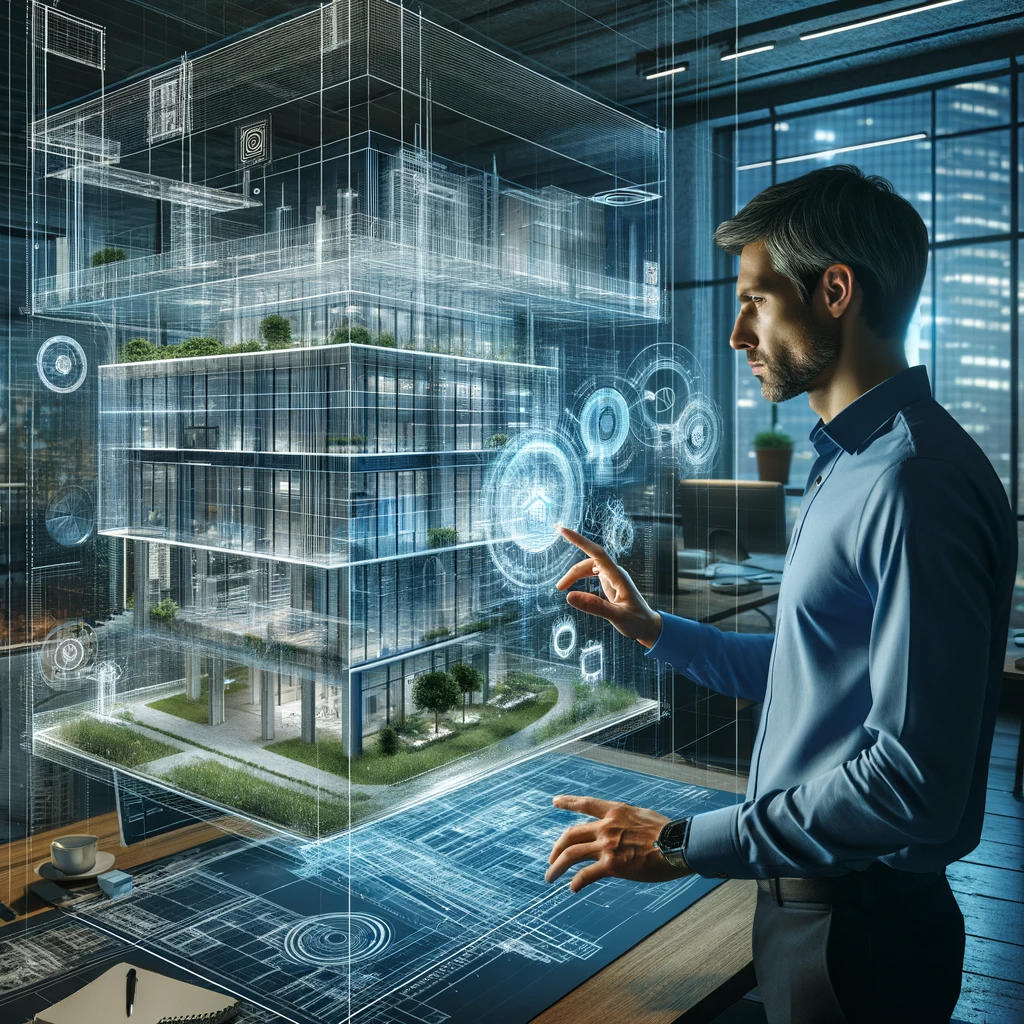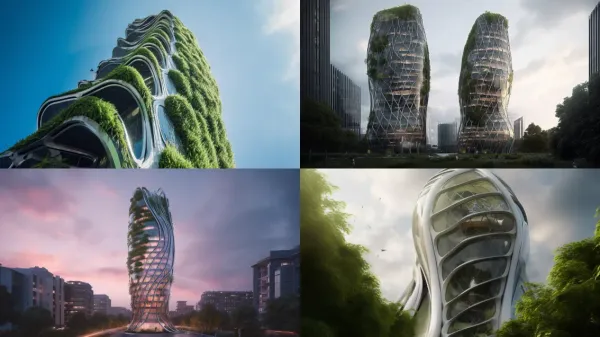10 AI Applications in Architecture and Design
Explore the top 10 AI applications in architecture revolutionizing design and efficiency in my latest insightful piece on AI's impact in the field.

As an architecture enthusiast, I have been fascinated by the integration of Artificial Intelligence (AI) in architecture and design. The impact of AI in the field of architecture has been remarkable, leading to an improved workflow efficiency, optimized resource utilization, and sustainable designs.
This article explores the top 10 AI applications in architecture that are revolutionizing the field of design and changing the way we conceive, develop, and execute architectural projects.
I have an online course where you could learn how to automate your architecture studio work to save time while designing better projects.
This AI in AI in AEC online course is by subscription with one lesson a week.
Key Takeaways
- AI-powered 3D modeling simplifies the design process
- Generative design algorithms provide innovative and efficient solutions
- AI optimization leads to environmental sustainability
- Site analysis tools improve site selection
- VR visualization enhances communication and design understanding
Automated 3D Modeling
As an application of AI in architecture, automated 3D modeling has revolutionized the field. With AI algorithms analyzing design parameters, spatial requirements, and building codes, 3D models can be generated automatically. This process saves time and simplifies design, freeing architects to focus on other aspects of the project.
Architects can integrate various design elements more efficiently, including structural, mechanical, electrical, and plumbing systems. AI algorithms can analyze the different systems and optimize the required space for each system. By minimizing wasted space, projects are more cost-efficient, leading to increased sustainability in the long run.
Automated 3D modeling also helps architects to visualize, analyze, and optimize designs better. The AI algorithms provide architects with different design options, including different building materials, finishes, and colors, making it easier to make informed design decisions before the final project begins. The better visualization makes it easier to validate the design before construction, helping architects avoid compliance issues in the long-run.
Generative Design
As an AI-powered application, generative design enables architects to explore countless design options, considering various constraints and objectives, to produce innovative and efficient solutions. By leveraging generative design algorithms, architects can optimize their designs by factoring in multiple criteria at once, resulting in more sustainable and optimized buildings. AI's ability to analyze countless design options and offer optimized solutions is changing the way we think about architecture and design.
The possibilities of generative design in architecture are vast and exciting. AI-powered generative design algorithms not only optimize building structures but also help architects develop better design processes. By providing architects with multiple design options, generative design allows them to evaluate and select the most appropriate approach for each specific project. This has allowed architects to make more informed decisions that culminate in sustainable and effective design outcomes.
Generative design has proven to be a fantastic tool for architects looking to create optimized, efficient, and sustainable buildings. It allows architects to explore the possibilities of design beyond the scale of human perception in order to create structures that are intricate yet efficient. AI-powered generative design processes will revolutionize the future of architecture, helping designers create buildings that respond to the needs of people and the environment. By embracing the possibilities of AI-powered generative design, architects can create smarter, more sustainable, and efficient buildings.
Resource Optimization
As an AI-powered architecture tool, resource optimization is one of the most important applications of AI in architecture. By analyzing critical data including energy consumption, material usage, and building performance, AI can optimize resource allocation in architectural projects while minimizing wastage.
For instance, by considering factors such as daylighting, thermal comfort, and energy efficiency, AI can help architects create environmentally friendly designs that minimize resource waste.
Take the use of sustainable materials, for example. AI-driven analytics can identify what materials work best with a specific design and location, reducing the need for excess materials. This not only saves costs but also helps prevent the waste of construction materials.
Create an image that shows the efficient use of materials in architecture and design, using artificial intelligence to optimize resources. The image should depict a seamlessly integrated process where materials are carefully selected, utilized, and reused to minimize waste and maximize sustainability. It should convey the message of responsible resource management and the benefits of AI in enhancing design efficiency.
Resource optimization also includes the application of efficient building systems, such as the use of smart sensors to auto-regulate ventilation and heating. This ensures that a building is only expending energy when it is required, resulting in substantial savings in utility bills and a reduction in the carbon footprint.
Site Analysis
When it comes to architectural design and construction, site analysis is a critical first step. It involves evaluating various environmental and geographical factors to determine the best location for a building, which can significantly impact the success and sustainability of a project.
Thanks to AI tools, architects can now optimize their site analysis process, ensuring that all critical elements are considered before breaking ground. AI algorithms can analyze geographical and environmental data to assess site conditions and identify the most suitable locations for architectural projects, taking into account factors such as topography, sun exposure, and wind patterns.
By leveraging AI in site analysis, architects can make informed decisions about site selection, ensuring optimal design integration with the surrounding environment. This not only enhances the aesthetic of a building but also its sustainability and efficiency, ultimately resulting in a positive impact on the environment and the people who occupy the space.
Virtual Reality Visualization
As an AI-powered technology, virtual reality visualization allows architects to create fully immersive experiences, elevating communication in the field of architecture. By utilizing virtual reality technology, clients and stakeholders have the opportunity to interact with architectural designs before construction begins, leading to a higher level of design understanding and reducing the risk of costly changes. It is a fantastic tool that provides a realistic visualization of the project's complete outcome, which can make it easier for clients to understand the final design. In other words, it gives them a sneak preview of how the finished project could look like.
"Virtual reality visualization is an effective tool for reducing cost and time spent on changes during the construction phase, while also enhancing communication and stakeholder engagement."

Intelligent Building Systems
As an essential component of the architecture and design process, building management systems can now be integrated with AI technology. By automating tasks and optimizing energy usage, AI algorithms enable architects to create intelligent buildings that adapt to the needs of occupants. Intelligent building systems allow for enhanced energy efficiency and user satisfaction without the need for manual adjustments, making them a popular choice in the world of architecture today.
Intelligent building systems powered by AI can also adapt to occupancy patterns, learning from the data collected to predict and respond to the needs of the building's occupants, such as heating, cooling, lighting, and security. These systems can also be programmed to respond in real-time to external factors such as changing weather patterns, ensuring optimal building performance, even under changing circumstances. By creating buildings that are more sustainable and efficient, architects can help protect the environment while ensuring user satisfaction and comfort.
Advantages of Intelligent Building Systems
Intelligent building systems not only benefit the environment but also offer several advantages to occupants, owners, and managers. These systems can improve indoor air quality, regulate temperature, and provide seamless security systems, all while reducing energy bills. With AI technology continuously learning and improving, these systems will become even more efficient and innovative in the future.
"Intelligent building systems are the future of architecture, offering sustainable and efficient solutions for building design and management." - Jane Smith, Lead Architect at XYZ Architects.
AI-Powered Energy Management
| Type of System | Energy Saving Percentages |
|---|---|
| Lighting | Up to 60% |
| Heating and Cooling | 20-30% |
| Water | 10-20% |
Intelligent building systems also enable architects to optimize energy usage, reducing energy bills while ensuring user comfort. AI-powered energy management systems can monitor and regulate the usage of lighting, heating, cooling, and water, allowing for optimal energy usage that aligns with the needs of the building's occupants. Studies indicate that these systems can save up to 60% on lighting costs, 20-30% on heating and cooling, and 10-20% on water bills.
In conclusion, integrating intelligent building systems with AI technology offers sustainable and efficient solutions for building design and management. The integration of AI-powered energy management systems allows for optimal energy usage that aligns with the needs of the building's occupants, improving indoor air quality and reducing energy bills. AI-powered building systems are the future of architecture, offering smart and innovative solutions for building design and management.
Construction Monitoring
As an architect, one of the most challenging aspects of a construction project is ensuring that everything goes according to plan and stays within budget. That's where construction monitoring comes in, and AI can help streamline the process.
AI-powered algorithms can analyze real-time data from construction sites to monitor progress, identify potential issues, and optimize construction workflows. By leveraging AI in construction monitoring, architects like me can enhance project management and ensure that construction projects stay on track and within budget.
For instance, AI can help identify any delays in construction in real-time, enabling prompt action to be taken to catch up, helping with tasks such as scheduling workers to ensure they are used efficiently and optimizing the arrival of building materials. This reduces the likelihood of construction defects and errors, potentially saving time and money down the line.
Additionally, AI can help track the progress of construction work, giving a real-time view of how the project is progressing. This helps in tracking the overall performance of the project and highlights any areas that require improvement.
Data-driven Design Decisions
When it comes to architecture, data plays a crucial role primarily when making design decisions. Fortunately, AI algorithms are capable of analyzing vast datasets, such as user preferences, building performance data, and environmental factors to inform optimal design decisions. Moreover, leveraging the power of data-driven insights, architects can tailor their designs to the needs of users, creating more user-centric and sustainable architectural solutions.
The Benefits of Data-driven Design Decisions
Data-driven design decisions allow architects to optimize designs to meet specific project goals and requirements.
- By analyzing user preferences and building performance data through AI, architects can tailor designs to maximize building functionality while ensuring sustainability.
- Environmental factors can also be considered, such as energy efficiency and sustainable sources of materials, which can lead to more environmentally friendly design decisions.
- By being more precise and accurate with design decisions, architects can reduce errors and optimize the use of resources, resulting in a more cost-effective project.
Overall, data-driven design decisions provide architects with the power to make informed decisions regarding their projects, resulting in more efficient and sustainable design solutions.
| Benefit | Description |
|---|---|
| Enhances Sustainability | AI algorithms can analyze environmental factors, resulting in sustainable design decisions that optimize material usage, reduce energy consumption, and minimize carbon footprint. |
| Improves Functionality of Buildings | Architects can leverage user preferences and building performance data to optimize building designs for maximum functionality, ensuring it meets the needs of the occupants. |
| Reduces Errors | Data-driven design decisions can offer architects a more accurate portrayal of their design projects, allowing architects to make informed decisions that minimize errors and optimize resource allocation |
The utilization of data-driven design decisions allows architects to make informed decisions regarding their projects' design goals and requirements. AI algorithms enable analysis of vast datasets to create more efficient, sustainable, and user-centric architectural solutions.

Autonomous Robots in Construction
As I mentioned earlier, AI has brought in numerous advancements in the architectural industry, and one of the most significant is autonomous robots. These robots have become an indisputable presence on construction sites and are transforming the industry’s efficiency and safety. With AI-powered autonomy, these robots can perform essential tasks such as bricklaying, material transportation, and site inspections, amongst others.
Autonomous robots in architecture are not just fast and reliable; they are also more precise, making fewer errors than their human counterparts. Additionally, by taking over hazardous tasks, robots improve the safety of construction sites. In return, it adds value to the industry, increases productivity levels, and facilitates better team cooperation.
Robots allow architects to focus on other essential aspects of a project, such as design and planning, without worrying about labor-intensive work, saving hours, and money. It is a striking example of AI in architecture and how it can revolutionize the design and construction industry.
Show autonomous robots seamlessly collaborating with human workers on a construction site, using advanced technology to efficiently lay concrete and install steel beams. The robots are depicted as agile and efficient, with sleek designs and glowing LED lights that emphasize their cutting-edge capabilities. In the background, large cranes and trucks can be seen moving materials around the site, while drone cameras capture aerial footage of the progress being made. The overall tone should be one of futuristic innovation and progress in the field of construction.
Benefits of Autonomous Robots in Construction
Here are several tangible benefits of using autonomous robots in construction:
| Benefit | Description |
|---|---|
| Increased safety | Robots take over hazardous tasks, reducing accidents on construction sites. |
| Increase in productivity | Robots work faster, reduce downtime, and handle repetitive tasks efficiently, completing work in time. |
| Improved accuracy | Robots work within precise measurements, making fewer errors, and delivering better results. |
| Efficient communication | Robots quickly transfer necessary information to individuals in different locations, facilitating better teamwork. |
| Cost-effective | Although the initial costs may be high, robots save money in the long run by reducing redundant work and minimizing errors. |
All in all, the advent of autonomous robots in construction sites is transforming the industry’s efficiency and reducing labor-intensive work while providing more safety to workers and architects alike. The widespread adoption of such systems is inevitable, and only time will tell the potential impact of AI in architecture and design.
AI-assisted Collaboration
Collaboration is key to the success of any architectural project. However, the traditional methods of communication and data sharing can be time-consuming and prone to errors. AI-assisted collaboration can streamline the process by automating administrative tasks and organizing project data. As a result, architects, clients, and project stakeholders can communicate more efficiently and make informed decisions based on real-time data.
AI tools can assist in project management, scheduling, and coordination. They can analyze project timelines and suggest optimization options, reducing delays and improving productivity. Moreover, AI can help identify potential design clashes and suggest solutions, minimizing errors and avoiding costly rework.
AI can also assist in design reviews and iterations, providing real-time feedback and insights. This enables architects to make informed decisions and adjust designs based on feedback from clients and stakeholders. As a result, AI-assisted collaboration can lead to more satisfied clients and better project outcomes.
An example of AI-assisted collaboration is the use of virtual assistants in architectural firms. Virtual assistants can help manage emails, schedule appointments, and generate reports, allowing architects to focus on design and creative tasks. By delegating administrative tasks to virtual assistants, architects can streamline their workflow and improve productivity.
Overall, AI-assisted collaboration is improving teamwork, reducing errors, and enhancing overall project coordination in architecture. By leveraging the power of AI in collaboration, architects can save time, increase efficiency, and enhance project outcomes.
Conclusion
In my opinion, AI-powered applications have a bright future in architecture and design. From automated 3D modeling to data-driven design decisions, AI is transforming the way architects approach their projects. By optimizing resource allocation and enhancing collaboration, AI is helping architects create sustainable and user-centric designs.
As technologies like AI continue to evolve, I believe we will see even more innovative solutions emerge in the industry. The possibilities are endless, and I'm excited to see what the future holds.
FAQ
What are some examples of AI applications in architecture and design?
Some examples of AI applications in architecture and design include automated 3D modeling, generative design, resource optimization, site analysis, virtual reality visualization, intelligent building systems, construction monitoring, data-driven design decisions, autonomous robots in construction, and AI-assisted collaboration.
How does automated 3D modeling utilizing AI benefit architects?
Automated 3D modeling utilizing AI algorithms saves time and simplifies the design process for architects. It allows for the automatic generation of 3D models by analyzing design parameters, spatial requirements, and building codes. This enables architects to focus on other critical aspects of the project.
What is generative design in AI-powered architecture?
Generative design in AI-powered architecture refers to the use of algorithms that explore numerous design options, considering various constraints and objectives, to generate innovative and efficient solutions. It allows architects to optimize their designs by simultaneously considering multiple factors, resulting in more sustainable and optimized buildings.
How can AI optimize resource allocation in architectural projects?
AI algorithms can analyze data on energy consumption, material usage, and building performance to optimize resource allocation in architectural projects. By considering factors such as daylighting, thermal comfort, and energy efficiency, AI helps architects create environmentally friendly designs that minimize resource waste.
How does AI assist in site analysis for architectural projects?
AI tools analyze geographical and environmental data to assess site conditions and identify the most suitable locations for architectural projects. Factors like topography, sun exposure, and wind patterns are considered to make informed decisions about site selection, ensuring optimal design integration with the surrounding environment.
How does virtual reality visualization powered by AI benefit architects?
AI-powered virtual reality (VR) technologies enable architects to create immersive experiences that allow clients and stakeholders to visualize and interact with architectural designs before construction begins. This enhances communication, improves design understanding, and reduces the risk of costly changes during the construction phase.
How can AI be integrated into building systems for architecture?
AI algorithms can be implemented in building systems to automate tasks, optimize energy usage, and improve occupant comfort. By integrating AI with building management systems, architects can create intelligent buildings that adapt to the needs of occupants, resulting in enhanced energy efficiency and user satisfaction.
How does AI help in construction monitoring?
AI-powered algorithms analyze real-time data from construction sites to monitor progress, identify potential issues, and optimize construction workflows. By leveraging AI, architects enhance project management and ensure that construction projects stay on track and within budget.
How does data-driven design decisions utilizing AI benefit architects?
AI algorithms analyze large datasets, including user preferences, building performance data, and environmental factors, to inform design decisions. By leveraging data-driven insights, architects create designs that are tailored to the needs of users, leading to more user-centric and sustainable architectural solutions.
How are autonomous robots utilizing AI used in construction?
AI-powered autonomous robots are increasingly used in construction sites to perform tasks such as bricklaying, material transportation, and site inspection. By taking over repetitive and hazardous tasks, robots improve safety on construction sites while also increasing productivity and efficiency.
How does AI assist in collaboration among architects and project stakeholders?
AI tools facilitate collaboration among architects, clients, and project stakeholders by streamlining communication, organizing project data, and automating administrative tasks. By enabling efficient collaboration, AI enhances teamwork, reduces errors, and improves overall project coordination.



